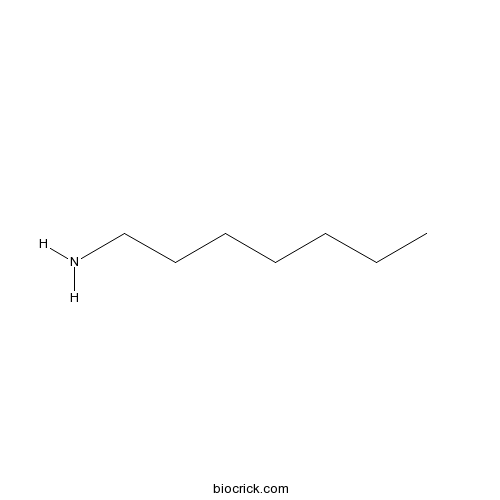1-HeptylamineCAS# 111-68-2 |

Quality Control & MSDS
3D structure
Package In Stock
Number of papers citing our products

| Cas No. | 111-68-2 | SDF | Download SDF |
| PubChem ID | 8127 | Appearance | Oil |
| Formula | C7H17N | M.Wt | 115.22 |
| Type of Compound | Alkaloids | Storage | Desiccate at -20°C |
| Solubility | Soluble in Chloroform,Dichloromethane,Ethyl Acetate,DMSO,Acetone,etc. | ||
| Chemical Name | heptan-1-amine | ||
| SMILES | CCCCCCCN | ||
| Standard InChIKey | WJYIASZWHGOTOU-UHFFFAOYSA-N | ||
| General tips | For obtaining a higher solubility , please warm the tube at 37 ℃ and shake it in the ultrasonic bath for a while.Stock solution can be stored below -20℃ for several months. We recommend that you prepare and use the solution on the same day. However, if the test schedule requires, the stock solutions can be prepared in advance, and the stock solution must be sealed and stored below -20℃. In general, the stock solution can be kept for several months. Before use, we recommend that you leave the vial at room temperature for at least an hour before opening it. |
||
| About Packaging | 1. The packaging of the product may be reversed during transportation, cause the high purity compounds to adhere to the neck or cap of the vial.Take the vail out of its packaging and shake gently until the compounds fall to the bottom of the vial. 2. For liquid products, please centrifuge at 500xg to gather the liquid to the bottom of the vial. 3. Try to avoid loss or contamination during the experiment. |
||
| Shipping Condition | Packaging according to customer requirements(5mg, 10mg, 20mg and more). Ship via FedEx, DHL, UPS, EMS or other couriers with RT, or blue ice upon request. | ||
| Description | 1-Heptylamine is a natural product from Tectona grandis. |
| Structure Identification | Spectrochim Acta A Mol Biomol Spectrosc. 2013 Oct;114:668-80.Vibrational spectroscopic investigation and conformational analysis of 1-heptylamine: a comparative density functional study.[Pubmed: 23823586]FT-IR and Raman spectra of 1-Heptylamine (1-ha) have been recorded in the region of 4000-10 cm(-1) and 4000-50 cm(-1), respectively. |

1-Heptylamine Dilution Calculator

1-Heptylamine Molarity Calculator
| 1 mg | 5 mg | 10 mg | 20 mg | 25 mg | |
| 1 mM | 8.679 mL | 43.3952 mL | 86.7905 mL | 173.581 mL | 216.9762 mL |
| 5 mM | 1.7358 mL | 8.679 mL | 17.3581 mL | 34.7162 mL | 43.3952 mL |
| 10 mM | 0.8679 mL | 4.3395 mL | 8.679 mL | 17.3581 mL | 21.6976 mL |
| 50 mM | 0.1736 mL | 0.8679 mL | 1.7358 mL | 3.4716 mL | 4.3395 mL |
| 100 mM | 0.0868 mL | 0.434 mL | 0.8679 mL | 1.7358 mL | 2.1698 mL |
| * Note: If you are in the process of experiment, it's necessary to make the dilution ratios of the samples. The dilution data above is only for reference. Normally, it's can get a better solubility within lower of Concentrations. | |||||

Calcutta University

University of Minnesota

University of Maryland School of Medicine

University of Illinois at Chicago

The Ohio State University

University of Zurich

Harvard University

Colorado State University

Auburn University

Yale University

Worcester Polytechnic Institute

Washington State University

Stanford University

University of Leipzig

Universidade da Beira Interior

The Institute of Cancer Research

Heidelberg University

University of Amsterdam

University of Auckland

TsingHua University

The University of Michigan

Miami University

DRURY University

Jilin University

Fudan University

Wuhan University

Sun Yat-sen University

Universite de Paris

Deemed University

Auckland University

The University of Tokyo

Korea University
- Oleylethanolamide
Catalog No.:BCC7084
CAS No.:111-58-0
- Diethanolamine
Catalog No.:BCN1797
CAS No.:111-42-2
- Decanedioic acid
Catalog No.:BCN5996
CAS No.:111-20-6
- Squalene
Catalog No.:BCN5995
CAS No.:111-02-4
- PF-04620110
Catalog No.:BCC2335
CAS No.:1109276-89-2
- Tunicamycin
Catalog No.:BCC7699
CAS No.:11089-65-9
- [Sar9,Met(O2)11]-Substance P
Catalog No.:BCC6960
CAS No.:110880-55-2
- Wilforine
Catalog No.:BCN5994
CAS No.:11088-09-8
- Entrectinib
Catalog No.:BCC6410
CAS No.:1108743-60-7
- Sparfloxacin
Catalog No.:BCC4848
CAS No.:110871-86-8
- MCOPPB trihydrochloride
Catalog No.:BCC4161
CAS No.:1108147-88-1
- Cinobufotalin
Catalog No.:BCN2283
CAS No.:1108-68-5
- Methyl Laurate
Catalog No.:BCC8211
CAS No.:111-82-0
- Deacetylsalannin
Catalog No.:BCN4733
CAS No.:1110-56-1
- (-)-Dihydroquercetin
Catalog No.:BCN3370
CAS No.:111003-33-9
- Efonidipine hydrochloride monoethanolate
Catalog No.:BCC7767
CAS No.:111011-76-8
- 2-Amino-1-phenylethanol
Catalog No.:BCN1779
CAS No.:7568-93-6
- Muricatide
Catalog No.:BCN1780
CAS No.:111025-01-5
- Pioglitazone
Catalog No.:BCC4927
CAS No.:111025-46-8
- Vitamin A2
Catalog No.:BCC8367
CAS No.:11103-57-4
- Ruthenium Red
Catalog No.:BCC7067
CAS No.:11103-72-3
- Annonacin
Catalog No.:BCN4734
CAS No.:111035-65-5
- 2-(2'-Hydroxy-4'-methylphenyl)propionic acid
Catalog No.:BCN7980
CAS No.:111044-84-9
- Ginkgolic acid C17:1
Catalog No.:BCN5334
CAS No.:111047-30-4
Vibrational spectroscopic investigation and conformational analysis of 1-heptylamine: a comparative density functional study.[Pubmed:23823586]
Spectrochim Acta A Mol Biomol Spectrosc. 2013 Oct;114:668-80.
FT-IR and Raman spectra of 1-Heptylamine (1-ha) have been recorded in the region of 4000-10 cm(-1) and 4000-50 cm(-1), respectively. The conformational analysis, optimized geometric parameters, normal mode frequencies and corresponding vibrational assignments of 1-ha (C7H17N) have been examined by means of the Becke-3-Lee-Yang-Parr (B3LYP) density functional theory (DFT) method together with the 6-31++G(d,p) basis set. Furthermore, reliable vibrational assignments have been made on the basis of potential energy distribution (PED) and the thermodynamics functions, highest occupied and lowest unoccupied molecular orbitals (HOMO and LUMO) of 1-ha have been predicted. Calculations have been carried out with the possible ten conformational isomers (TT, TG, GT, GT1, GG1, GG2, GG3, GG4, GG5, GG6; T and G denote trans and gauge) of 1-ha, both in gas phase and in solution. Solvent effects have theoretically been investigated using benzene and methanol. All results indicate that the B3LYP method provides satisfactory evidence for the prediction of vibrational frequencies and the TT isomer is the most stable form of 1-ha.


